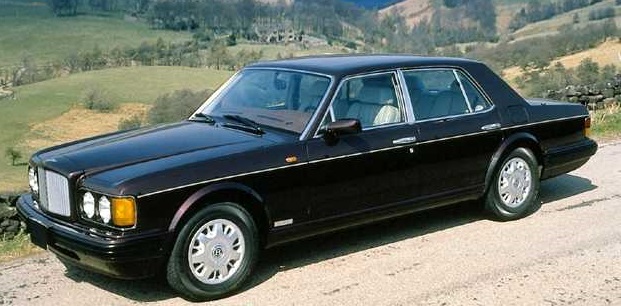

Sedan, 4 Doors, 5 Seats
18.3 l/100 km 12.85 US mpg
248 Hp @ 4000 rpm.
36.7 Hp/l
214 km/h 132.97 mph
6750 cm3
411.91 cu. in.
8, V-engine
Rear wheel drive,
5294 mm
208.43 in.
1914 mm
75.35 in.
2430 kg
5357.23 lbs.
| Brand | Bentley |
|---|---|
| Model | Brooklands (Sedan) |
| Version | Brooklands |
| Engine version | 6.7 i V8 (248 Hp) |
| Year production start | 1994 |
| Year production end | 1998 |
| Vehicle type | Sedan |
| Horsepower RPM | 248 Hp @ 4000 rpm. |
| Acceleration 0 - 100 kmh sec | 9.5 sec |
| Curb weight kg -lbs total |
2430 kg5357.23 lbs. |
| Overall length mm - inch |
5294 mm208.43 in. |
| Doors | 4 |
| Top Speed | 214 km/h 132.97 mph |
| Engine position and orientation | Front, Longitudinal |
|---|---|
| Cylinders | 8 |
| Position of cylinders | V-engine |
| Displacement (liters) |
6750 cm3411.91 cu. in. |
| Eng. horsepower RPM | 248 Hp @ 4000 rpm. |
| Horsepower per litre | 36.7 Hp/l |
| Weight / horsepower kg/hp - hp/tons |
9.8 kg/Hp102.1 Hp/tonne |
| Weight / torque kg/Nm - Nm/tons | 4.8 kg/Nm, 207 Nm/tonne
4.8 kg/Nm207 Nm/tonne |
| Torque Nm RPM lb-ft RPM |
503 Nm @ 1900 rpm.370.99 lb.-ft. @ 1900 rpm. |
| Bore (mm in) |
104.1 mm4.1 in. |
| Stroke (mm in) |
99.1 mm3.9 in. |
| Compression ratio | 8.7 |
| Fuel delivery system | Multi-point indirect injection |
| Fuel type | Petrol (Gasoline) |
| Valvetrain | 2 |
| Engine aspiration | Naturally aspirated engine |
| Engine oil liters | quarts |
9.4 l9.93 US qt | 8.27 UK qt |
| Engine coolant |
18 l19.02 US qt | 15.84 UK qt |
| Powertrain architecture | Internal Combustion engine |
| Engine location | Front, Longitudinal |
| Drive configuration | Rear wheel drive |
|---|
| Front brakes | Ventilated discs |
|---|---|
| Rear brakes | Ventilated discs |
| Brake control | Disc |
| Anti-lock brake system | ABS (Anti-lock braking system) |
| Front suspension | Double wishbone |
|---|---|
| Rear suspension | Spring Strut |
| Wheels size | 235/65 R16V |
|---|
| Passengers seats | 5 |
|---|---|
| Trunk space min liter | cu. Ft. |
410 l14.48 cu. ft. |
| Overall length mm - inch |
5294 mm208.43 in. |
|---|---|
| Overall width mm -inch |
1914 mm75.35 in. |
| Overall height mm -inch |
1485 mm58.46 in. |
| Wheelbase mm - inch |
3061 mm120.51 in. |
| Track width front mm - inch |
1549 mm60.98 in. |
| Track width rear mm - inch |
1549 mm60.98 in. |
| Curb weight kg -lbs total |
2430 kg5357.23 lbs. |
|---|---|
| Gross weight kg -lbs total |
2930 kg6459.54 lbs. |
| Capacities kg - lbs |
500 kg1102.31 lbs. |
| Fuel tank liters | gallons |
108 l28.53 US gal | 23.76 UK gal |
| Combined l/100 km - Mpg |
18.3 l/100 km12.85 US mpg |
|---|---|
| Autonomy km (combined use) | 600 |
8 CYLINDER V-Engine
https://www.thecarspec.net/components/engine/8-cylinders-v